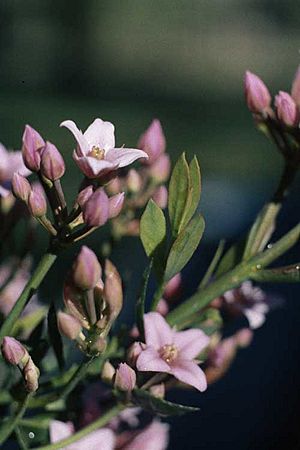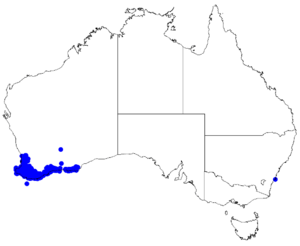Boronia spathulata facts for kids
Quick facts for kids Boronia spathulata |
|
|---|---|
 |
|
| Scientific classification | |
 |
|
| Occurrence data from Australasian Virtual Herbarium |
Boronia spathulata is a beautiful plant that belongs to the citrus family, called Rutaceae. You can only find this plant growing naturally in the south-western part of Western Australia. It's a smooth shrub with leaves that are shaped like eggs or ovals. Its flowers are pink and have four petals.
Contents
What Does Boronia Spathulata Look Like?
Boronia spathulata is a smooth shrub that can grow up to about 1 m (3 ft 3 in) tall. It has leaves that are spaced out along its branches. These leaves are usually narrow and oval-shaped, or sometimes wider and egg-shaped. They are about 10–20 mm (0.39–0.79 in) long. Leaves closer to the ends of the branches often look more like small cylinders.
The flowers grow in small groups. Each flower sits on a short red stalk called a pedicel. At the bottom of these stalks, there are tiny leaf-like parts called bracts. The flowers on the sides have stalks that are about 3–4 mm (0.12–0.16 in) long.
Each flower has four parts that look like small leaves, called sepals. These are triangular or egg-shaped and about 2.5–4 mm (0.1–0.2 in) long. Then there are four pink, egg-shaped petals, which are the colorful parts of the flower. They are about 6–9 mm (0.2–0.4 in) long. Inside the flower, there are eight stamens, which are the parts that produce pollen. They are a bit hairy and have a small white tip. The stigma, which receives pollen, is only slightly bigger than the style, which connects it to the ovary. You can usually see these flowers blooming in most months of the year.
How Did Boronia Spathulata Get Its Name?
The plant Boronia spathulata was first officially described in 1839. A scientist named John Lindley wrote about it in a book called A Sketch of the Vegetation of the Swan River Colony.
The second part of its name, spathulata, comes from a Latin word, spathe. This word means a broad blade or a paddle used for stirring. This name likely describes the shape of some part of the plant, perhaps its leaves or petals.
Where Does Boronia Spathulata Grow?
This type of boronia plant likes to grow in sandy soil. You can often find it near swamps or rivers. It also grows in jarrah forests.
Its natural home is in Western Australia. It grows in an area stretching from the city of Perth down to Augusta, and then east towards Israelite Bay.
Is Boronia Spathulata Threatened?
The good news is that Boronia spathulata is not considered to be in danger. The Western Australian Government's Department of Parks and Wildlife has classified it as "not threatened." This means there are enough of these plants in the wild, and they are not at risk of disappearing.

